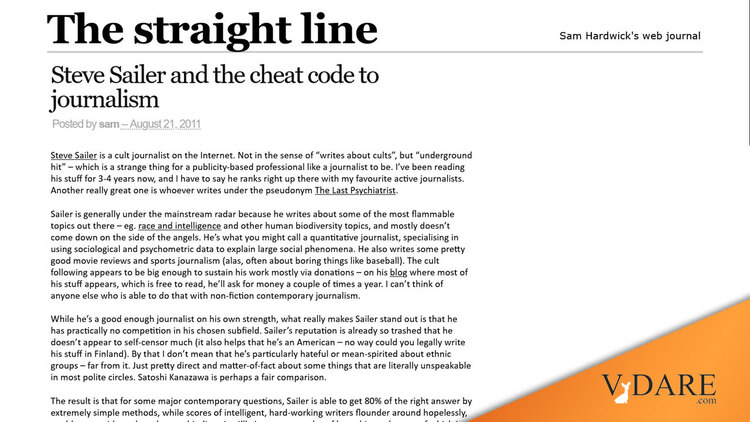Earlier: PISA Scores Show Demography Is Destiny In Education Too—But Washington Doesn’t Want You To Know
Remember blogging? Here’s a 12-year-old blog by a Finn who used the name Sam Hardwick:
Steve Sailer and the cheat code to journalism
Posted by sam – August 21, 2011Steve Sailer is a cult journalist on the Internet. Not in the sense of “writes about cults”, but “underground hit”— which is a strange thing for a publicity-based professional like a journalist to be. I’ve been reading his stuff for 3-4 years now, and I have to say he ranks right up there with my favourite active journalists. Another really great one is whoever writes under the pseudonym The Last Psychiatrist.
Sailer is generally under the mainstream radar because he writes about some of the most flammable topics out there—eg. race and intelligence and other human biodiversity topics, and mostly doesn’t come down on the side of the angels. He’s what you might call a quantitative journalist, specialising in using sociological and psychometric data to explain large social phenomena. He also writes some pretty good movie reviews and sports journalism (alas, often about boring things like baseball). The cult following appears to be big enough to sustain his work mostly via donations—on his blog where most of his stuff appears, which is free to read, he’ll ask for money a couple of times a year. I can’t think of anyone else who is able to do that with non-fiction contemporary journalism.
While he’s a good enough journalist on his own strength, what really makes Sailer stand out is that he has practically no competition in his chosen subfield. Sailer’s reputation is already so trashed that he doesn’t appear to self-censor much (it also helps that he’s an American—no way could you legally write his stuff in Finland). By that I don’t mean that he’s particularly hateful or mean-spirited about ethnic groups—far from it. Just pretty direct and matter-of-fact about some things that are literally unspeakable in most polite circles. Satoshi Kanazawa is perhaps a fair comparison.
The result is that for some major contemporary questions, Sailer is able to get 80% of the right answer by extremely simple methods, while scores of intelligent, hard-working writers flounder around hopelessly, unable to use ideas about human biodiversity. I’ll give two examples of how this works, one of which is from Sailer, and the other I noticed myself (I’m sure I’m not the first one to notice it).
The Sailer example is about the PISA international student assessment studies. A major point of interest in the US was the poor performance of the US; in Finland a point of interest was Finland’s excellent performance. A great deal has been written about both of these cases, mostly looking at the way public education is organised in these countries.
Sailer, who explains much of US sociology by differences in intelligence (he gives 110, 105, 100, 90 and 85 as rough IQ averages for Ashenazi Jews, Southeast Asians, European-descended whites, American Latinos and American blacks respectively (SD = 15)), obviously first looked at the US racial distribution of the PISA results.
Incidentally, this type of analysis is not possible in many other countries, because most countries don’t keep statistics about races or ethnic groups.
Anyway, this is what he came up with:…
When broken down by ethnicity, American students did reasonably well compared to the countries from which their ancestors came.
- Asian Americans outscored every Asian country, and lost out only to the city of Shanghai, China’s financial capital.
- White Americans students outperformed the national average in every one of the 37 historically white countries tested, except Finland (which is, perhaps not coincidentally, an immigration restrictionist nation where whites make up about 99 percent of the population).
- Hispanic Americans beat all eight Latin American countries.
- African Americans would likely have outscored any sub-Saharan country, if any had bothered to compete. The closest thing to a black country out of PISA’s 65 participants is the fairly prosperous oil-refining Caribbean country of Trinidad and Tobago, which is roughly evenly divided between blacks and South Asians. African Americans outscored Trinidadians by 25 points.
…
The second thing, the one that it occurred to me to look up, is the mystery of violence in America. Michael Moore made a movie about the US statistics in 2002, Bowling for Columbine. In it he searched for reasons for America’s violence—5.0 homicides per 100,000 people per year by the most recent figures (Finland has 2.5, the UK 1.28, Sweden 0.89). He looked at a lot of factors, settling on a mix with the main element being a culture of fear and isolation among middle-class whites. This cartoon segment has much the the main thesis.
Well, after reading Sailer, you can probably guess what I got an idea to look up. The 2009 numbers from the FBI give (for intentional homicides) 5,286 white offenders, 5,890 black offenders, 245 “other” and 4,339 “unknown”. If we forget about “other” and assume “unknown” is distributed like the knowns, we get 7,338 white and 8,177 black offenders. With population figures of 223,553,265 whites and 38,929,319 blacks (these are 2010 figures, but there’s not much difference), we get offending rates of 3.28 for whites and 21.00 for blacks.
The category “white” in this case includes Latinos, and the result of 3.28 is perhaps a bit higher than you’d expect for a mix of European whites (around 1.5) and a smallish number of people from Mexico, Venezuela, El Salvador, Columbia, Panama, … (15, 49, 71, 63, 24). The black rate of 21 is comparable to many West African countries (Mali 18, Liberia 17, Congo 20—however, Senegal is at 1.1 (!?)).
These calculations may be confounded by some factors like serial homicides, but as a first approximation, it again appears to give a big part of the picture, one that I can’t recall Michael Moore addressing at all.













